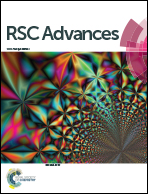An emission-tunable fluorescent organic molecule for specific cellular imaging†
Abstract
A novel fluorescent organic small molecule, 4,4′-((1E,1′E)-(2-(3-aminopropoxy)pyrimidine-4,6-diyl)bis(ethene-2,1-diyl))bis(N,N-diethylaniline) (PPBEN), was designed and synthesized. When PPBEN was dissolved in aqueous solution, its emission maximum showed a large blue shift compared with that in organic solution. The emission spectra of PPBEN could be finely tuned by controlling the water content in organic/water mixed solutions, resulting in a sequential color change of its fluorescence as a function of water fraction. Theoretical calculations illustrated that protonation of the tertiary amine groups of PPBEN was the main reason for this phenomenon. A pH-responsive study showed that an acidic aqueous environment increased the emission intensity of PPBEN, further proving that protonation affected its emission properties. Cell assays showed that PPBEN is suitable for cellular imaging. Colocalization analysis of PPBEN with a commercial lysosome dye demonstrated its potential application in specific lysosome imaging.


 Please wait while we load your content...
Please wait while we load your content...